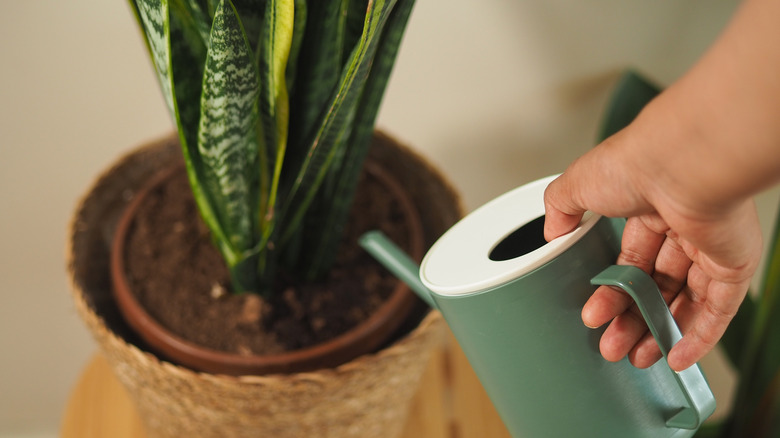The Main Reason You May Want To Avoid Growing A Snake Plant
The snake plant (Dracaena trifasciata, formerly Sansevieria trifasciata), also known as mother-in-law's tongue, is usually at the top of any list of houseplants for beginners. It's resistant to dry soil, heat, and low light — perfect for someone who may be a bit negligent with their plants or who may not have an abundance of sunlight in their home. In fact, it's a popular indoor plant for dark rooms. The snake plant also is ideal for small spaces, as it can grow upright quite compactly, versus many other houseplants that like to sprawl or vine through your living spaces. At the same time, the plant's spear-like foliage provides visual interest with its stripes, splotches, and margins, ranging from silver and white to bright yellow and dark green. One thing to be mindful of is that the plant is mildly toxic to pets and humans when ingested, and its sap can cause skin irritation.
Despite the plant's popularity for being an easy houseplant, many snake plant owners are guilty of overwatering, which can cause root rot and ultimately kill your plant. This may be a result of our hypervigilance around watering, as we aim to avoid the gap of death that plagues excessively dry soil. But when it comes to snake plants, this symptom of underwatering shouldn't be your greatest concern. Snake plants, like most succulents, hold water in their leaves, making them more tolerant to drought. If you've overwatered your snake plant, its leaves may turn yellow or flop over as an indication of unhealthy roots.
Tips for correctly watering a snake plant
If you are intent on growing a snake plant, learning more about its watering needs can lead to success. For starters, give the plant well-draining soil. Using a base of cactus and succulent potting mix, add materials that will promote drainage, such as perlite, coarse (not fine) sand, pea gravel, or slate chips. Aim for a consistency that feels crumbly, even when wet, rather than one that forms a dense clump. This will allow the water to move more readily through the soil. Also, make sure the pot has drainage holes. Terra cotta pots work well since they wick moisture out of the soil better than plastic containers.
When it comes to frequency, allow the soil to dry out between waterings during the plant's active season. But what does that mean exactly? How dry is dry, and how do you measure if your plants have had enough water? The easiest tool is at your fingertips — literally. Insert your finger about an inch or two into the soil. If the soil is wet, leave it alone. If you pull your finger out and the soil cleanly brushes off, it's time to water.
You do, however, want to avoid going from extreme dryness to saturation, a transition that may shock the plant. During this season, you can also supplement with a fertilizer for your snake plant with a balanced ratio (like 5-5-5 or 10-10-10) of nitrogen, phosphorus, and potassium. When the plant is dormant, water just once every 1 to 2 months. Even then, don't overly soak the plant or else its roots may end up sitting in sopping soil.

